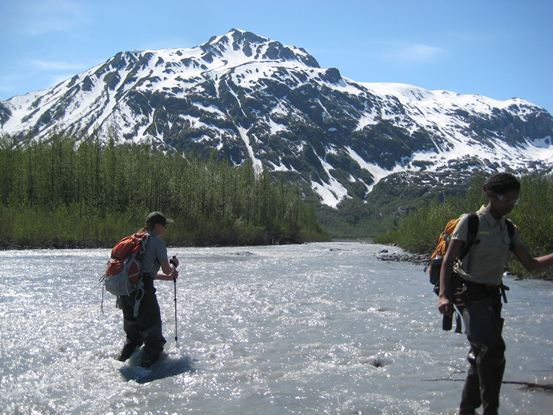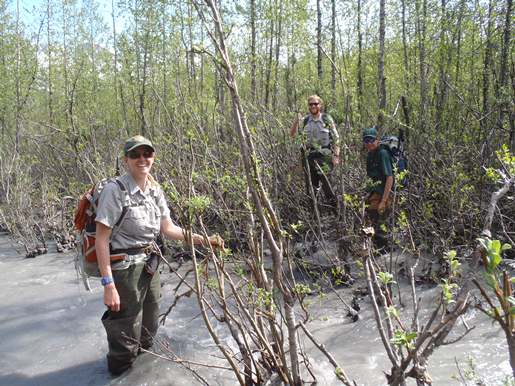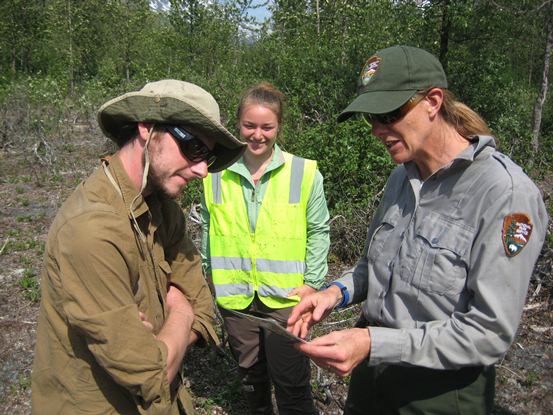As I put on my hip waders and powered up the GPS unit I found myself thinking an unfamiliar thought for an Alaskan; "man it's hot out here". It had been an unusually warm and dry June for Kenai Fjords National Park, but this week was supposed to be record setting with high temperatures predicted to reach the mid 80's. This heat was going to make crossing Exit Creek to survey for invasive plant species even more difficult for the Exotic Plant Management Team (EPMT). Exit Creek is fed by melt water from Exit Glacier as well as snow pack in the surrounding drainages and the heat wave had inundated the creek with meltwater.
As we made our way out of the alders and willows and onto the gravely bank on the western side of Exit Creek, the low roar of the water became audible. We scanned the fast moving water and found no obvious routes across, but we decided to give it a try. I stepped gingerly into the grey turbid waters and felt the current pushing hard against my legs. I side-stepped slowly, feeling along the bottom of the creek bed for rocks or ice chunks with my foot. After a few short steps I felt the icy water splashing over the top of my hip waders, the strong current eroding the gravel beneath my feet pushing me backwards and I decided it was time to turn back. We certainly would not be able to get across here. After several more attempts in different locations, with similar results, we finally found a safe crossing near the confluence of Exit Creek and the Resurrection River where the creek had braided out into wider and shallower channels.

EPMT staff crossing Exit Creek. Photo: NPS \ Peter Frank
Once across, we regrouped to assess the best route to our survey locations. The Exit Glacier outwash plain is a complex matrix of plant communities in various successional states interconnected with an abundance of game trails. The plant communities range from dense spruce and cottonwood forests to open shrubby gravel beds. Having crossed so far down on Exit Creek we would need to bushwhack (hike through thick brush with no trail) back to our survey sites. Guiding the bushwhack was like doing the maze on the back of a cereal box. I was looking at the aerial photography on the GPS unit and trying to snake my way through the patches of open shrubby vegetation to our final destination, while avoiding the densely forested areas. Bushwhacking can be unpleasant, especially when it's hot and buggy, but by planning ahead and utilizing the GPS unit we were able to navigate through this maze of vegetation to find our survey sites, and still maintain good team moral.

Bushwhacking on the Exit Glacier outwash plain. Photo: SCA \ Nara McCray

Physical maps and aerial photography are vital for navigation on the outwash plain. Photo: NPS \ Peter Frank
We had come all this way to survey for, monitor and map infestations of the non-native common dandelion (Taraxacum officinale). This species was first documented on the outwash plain in 2006 and has since expanded into multiple infestations that, in total, cover approximately 0.75 acres. Most infestations account for a very limited percent of the total vegetative cover in the area but some have grown and are now at densities which threaten to crowd out the native vegetation. It is unknown exactly how the common dandelions made their way across Exit Creek to the outwash plain since this area is rarely visited. It is possible that wind, animals or even park staff may have unknowingly transported the seeds across the river. The surveys and mapping preformed on this trip will help the Exotic Plant Management Team plan for control work on these infestations that will be conducted later this summer.
Once our selected sites had been surveyed and infestations were mapped we made our way back to Exit Creek following our GPS tracks from earlier that morning. We were able to cross Exit Creek safely to cap off an exciting and productive day.
